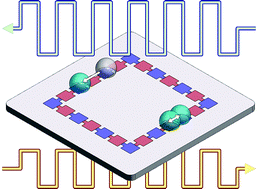Asymmetric electrowetting—moving droplets by a square wave†
Abstract
Here droplet oscillation and continuous pumping are demonstrated by asymmetric electrowetting on an open surface with embedded electrodes powered by a square wave electrical signal without control circuits. The polarity effect of electrowetting on an SU-8 and Teflon coated electrode is investigated, and it is found that the θ–V (contact angle–applied voltage) curve is asymmetric along the V = 0 axis by sessile drop and coplanar


 Please wait while we load your content...
Please wait while we load your content...